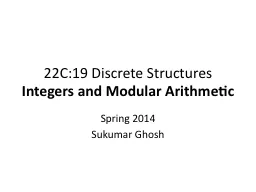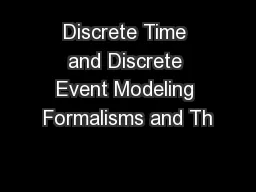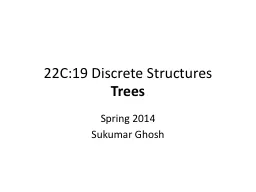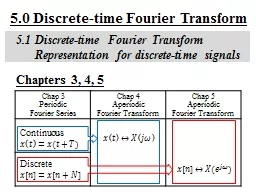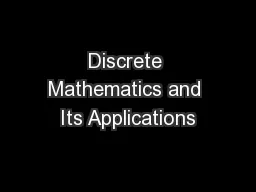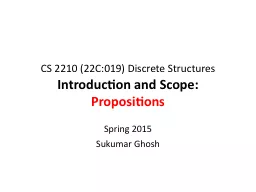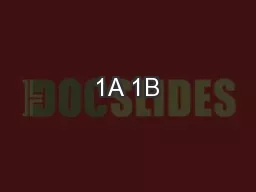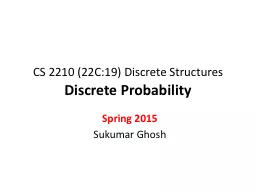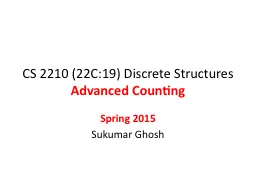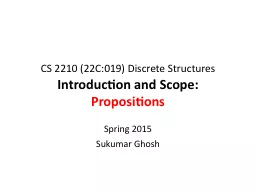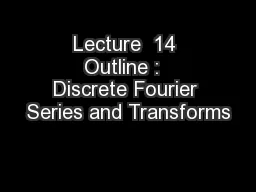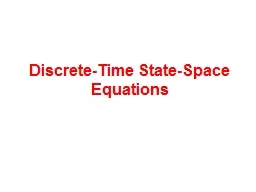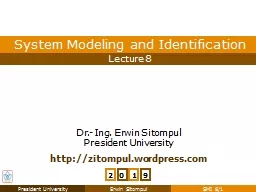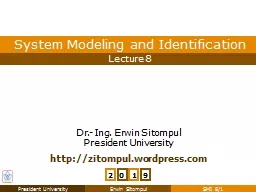PPT-22C:19 Discrete Structures
Author : tawny-fly | Published Date : 2016-03-07
Integers and Modular Arithmetic Spring 2014 Sukumar Ghosh Preamble Historically number theory has been a beautiful area of study in pure mathematics However
Presentation Embed Code
Download Presentation
Download Presentation The PPT/PDF document "22C:19 Discrete Structures" is the property of its rightful owner. Permission is granted to download and print the materials on this website for personal, non-commercial use only, and to display it on your personal computer provided you do not modify the materials and that you retain all copyright notices contained in the materials. By downloading content from our website, you accept the terms of this agreement.
22C:19 Discrete Structures: Transcript
Integers and Modular Arithmetic Spring 2014 Sukumar Ghosh Preamble Historically number theory has been a beautiful area of study in pure mathematics However in modern times number theory is very important in the . Introduction and . Scope. Propositions. Fall 2011. Sukumar Ghosh. The Scope. Discrete . mathematics. . studies mathematical . structures that are . fundamentally . discrete. ,. . not . supporting . Dr. Feng Gu. Way to study a system. . Cited from Simulation, Modeling & Analysis (3/e) by Law and . Kelton. , 2000, p. 4, Figure 1.1. Model taxonomy. Modeling formalisms and their simulators . Discrete time model and their simulators . Trees. Spring 2014. Sukumar Ghosh. What is a tree?. Rooted tree: recursive definition. Rooted tree terminology. Rooted tree terminology. A . subtree. Rooted tree terminology. Important properties of trees. 5.1 Discrete-time Fourier Transform . Representation for discrete-time signals. Chapters 3, 4, 5. Chap. 3 . Periodic. Fourier Series. Chap. 4 . Aperiodic . Fourier Transform . Chap. 5 . Aperiodic . Introductory Lecture. What is Discrete Mathematics?. Discrete mathematics is the part of mathematics devoted to the study of discrete (as opposed to continuous) objects.. Calculus deals with continuous objects and is not part of discrete mathematics. . Structures. Introduction and Scope:. Propositions. Spring 2015. Sukumar Ghosh. The Scope. Discrete . mathematics. . studies mathematical . structures that are . fundamentally . discrete. ,. . not . 1C. 1D. 2A. 2B. 2C. 2D. 3A. 3B. 3C. 3D. 4A. 4B. 4C. 4D. 5A. 5B. 5C. 6A. 6B. 6C. 7A. 7B. 7C. 8A. 8B. 8C. 9A. 9B. 9C. 10A. 10B. 10C. 11A. 11B. 11C. 12A. 12B. 12C. 13A. 13B. 13C. 14A. 14B. 14C. 15A. 15B. Discrete Probability. Spring 2015. Sukumar Ghosh. Sample Space. DEFINITION. . The . sample space S . of an experiment is the set . of possible outcomes. An . event. . E. is a . subset. of the sample space.. Advanced Counting. Spring 2015. Sukumar Ghosh. Compound Interest. A person deposits $10,000 in a savings account that yields . 10% interest annually. How much will be there in the account . after 30 years?. Structures. Introduction and Scope:. Propositions. Spring 2015. Sukumar Ghosh. The Scope. Discrete . mathematics. . studies mathematical . structures that are . fundamentally . discrete. ,. . not . Announcements:. HW . 4. . posted, . due Tues May 8 at 4:30pm. . No late HWs as solutions will be available immediately.. Midterm details on next page. HW . 5 will . be posted . Fri May 11. , . due . Equations. Outline. • Discrete-time state equation from . solution of . continuous-time state equation.. • Expressions in terms of . constituent matrices. .. • Example.. 2. Solution of State Equation. Chapter 5. Discrete-Time Process Models. Discrete-Time Transfer Functions. The input to the continuous-time system . G. (. s. ) is the signal:. The system response is given by the convolution integral:. Chapter 5. Discrete-Time Process Models. Discrete-Time Transfer Functions. The input to the continuous-time system . G. (. s. ) is the signal:. The system response is given by the convolution integral:.
Download Document
Here is the link to download the presentation.
"22C:19 Discrete Structures"The content belongs to its owner. You may download and print it for personal use, without modification, and keep all copyright notices. By downloading, you agree to these terms.
Related Documents

